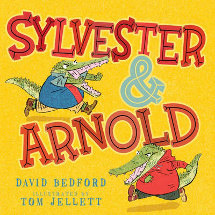Sylvester and Arnold by David Bedford and Tom Jellett

Little Hare, 2013. ISBN 9781921714542.
Sylvester was a BIG, TOUGH croc. And so was Arnold. Sylvester wore
tough-croc shorts, A tough-croc vest and tough-croc boots. When he
went out to play he put on an ugly tough-croc face. So did Arnold.
Both spent all day making sure that everyone in the big, wide swamp
where they lived knew who was boss. But they had never met, until
one day.
This is a delightful story of how these two crocs set out how to be
fiercer than the other but then an even bigger threat arrives and
suddenly they are bullies no longer. It has a twist in its tail that
is charming and offers much to discuss about being friends and
building friendships.
Tom Jellett's illustrations are the perfect accompaniment and offer
a lot to explore about perspective. Even though each page is the
same size, how does he manage to portray the size and fierceness of
Sylvester and Arnold and then dwarf this with his illustrations of
Betty?
There is plenty of scope for little ones to be both the fierce,
tough Sylvester and Arnold and then contrast that with the meek and
mild Sylvester and Arnold as they try to sneak away under the cover
of darkness. Whole-body interaction accompanied by emotions,
expressions and noise!
It would also serve as a great introduction to the research process
if you ask the students what they already know about crocodiles
before you read it. Then, afterwards, discuss which parts might be
true and which parts are made up. Share other fiction stories about
crocs and then contrast these with the factual resources
highlighting the difference between what is written for the
imagination and what is written for information. Introduce the
interpretation of text by showing how the Bedford and Jellett can
let their imaginations roam because their purpose is to entertain
rather than inform. If your non-fiction resources are separate from
the fiction, explain the library layout and where the crocodile
resources are located. And there are dozens of ways each could
present what they have learned to create an engaging display for the
library's walls. Who would have thought 32 pages could contain so
much?
Barbara Braxton